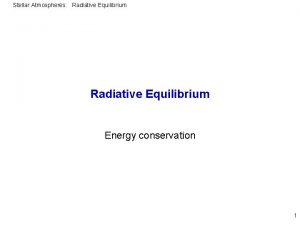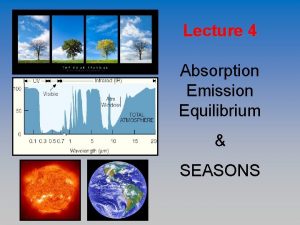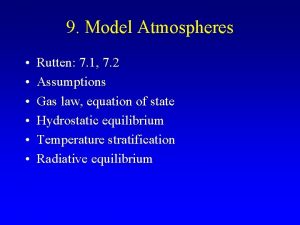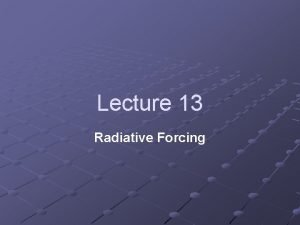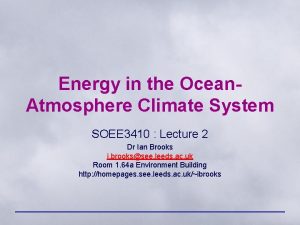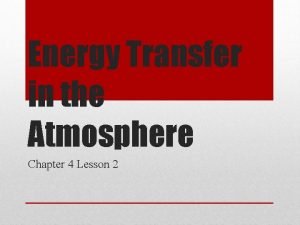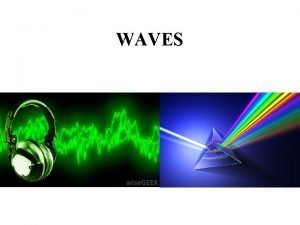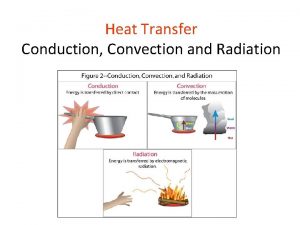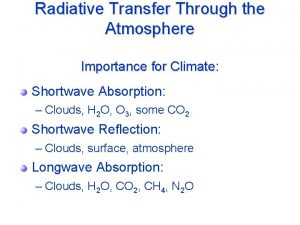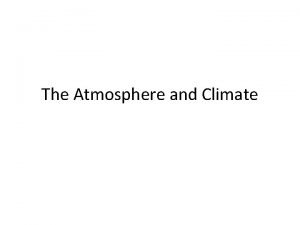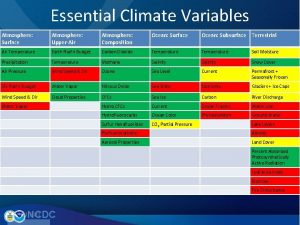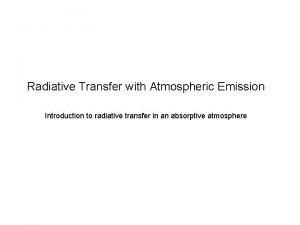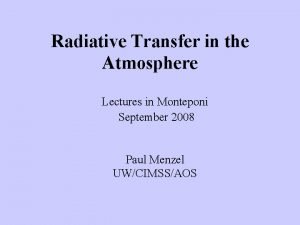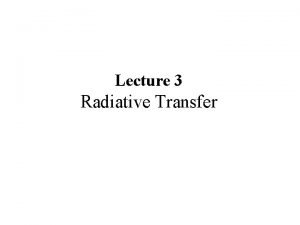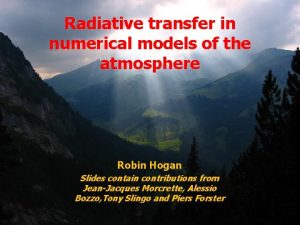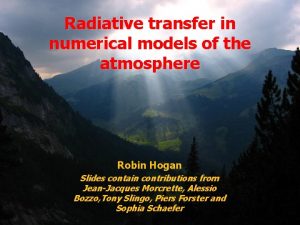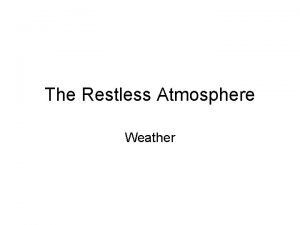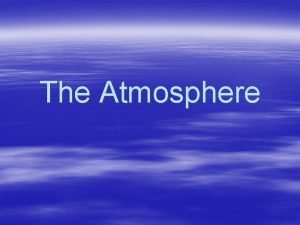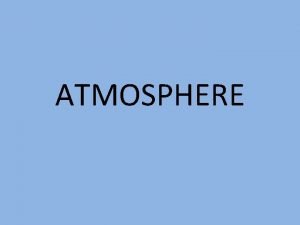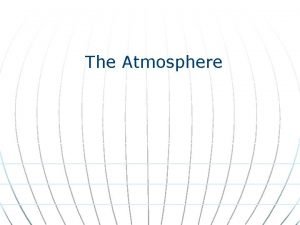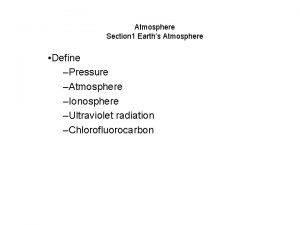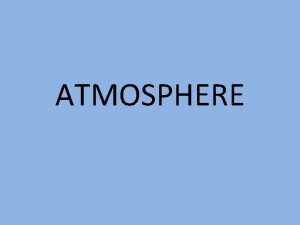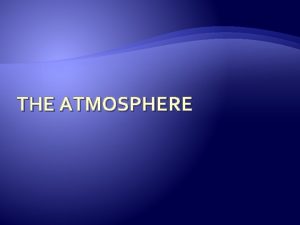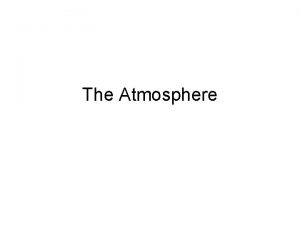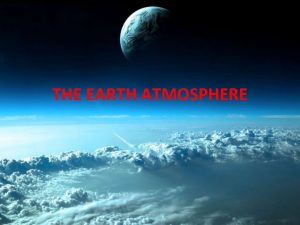Radiative Transfer Through the Atmosphere Importance for Climate












































- Slides: 44

Radiative Transfer Through the Atmosphere Importance for Climate: Shortwave Absorption: – Clouds, H 2 O, O 3, some CO 2 Shortwave Reflection: – Clouds, surface, atmosphere Longwave Absorption: – Clouds, H 2 O, CO 2, CH 4, N 2 O

Program Black-body radiation Interaction of radiation with gases Interaction of radiation with clouds and aerosols

Intensity Image credit: Kerry Emanuel

Intensity, Flux Density, Total Flux Intensity Flux density is the normal component of intensity integrated over all solid angles Total flux density is the flux density integrated over all wavelengths Total flux is the integral of the total flux density over area and is the radiant power in Watts

Intensity, Flux Density, Total Flux Intensity Flux density is the normal component of intensity integrated over all solid angles Total flux density is the flux density integrated over all wavelengths Total flux is the integral of the total flux density over area and is the radiant power in Watts

Intensity, Flux Density, Total Flux Intensity Flux density is the normal component of intensity integrated over all solid angles Total flux density is the flux density integrated over all wavelengths Total flux is the integral of the total flux density over area and is the radiant power in Watts

Intensity, Flux Density, Total Flux Intensity Flux density is the normal component of intensity integrated over all solid angles Total flux density is the flux density integrated over all wavelengths Total flux is the integral of the total flux density over area and is the radiant power in Watts

Intensity, Flux Density, Total Flux Intensity Flux density is the normal component of intensity integrated over all solid angles Total flux density is the flux density integrated over all wavelengths Total flux is the integral of the total flux density over area and is the radiant power in Watts

Black-body Radiation Planck’s Law Based on assumption of local thermodynamic equilibrium – (Not valid at very high altitudes in atmosphere)

Image credit: Darth Kule

Wien’s Displacement Law Wavelength of maximum emission

Pāhoehoe Lava, Hawaii Image credit: Hawaii Volcano Observatory

Image credit: NASA/IPAC

9 year image of background cosmic radiation Image credit: NASA/WMAP Science Team

Comparison of Black-body Curves of Earth and Sun Image credit: Kerry Emanuel

Image credit: NASA

The Stefan-Boltzmann Law is the integral of the Planck function over all frequencies and all angles in a hemisphere:

Emission and Absorption Spectra Image source: Kerry Emanuel

Emission and Absorption Spectra Image source: Kerry Emanuel

Emission and Absorption Spectra Image source: Kerry Emanuel

Absorption and Emission in a Gas

Electronic Transitions Electric transition in the quantum energy states of an atom resulting in the emission of a photon Image credit: Willow, Wikipedia

Electronic Transitions An isolated atom can absorb only those photons whose energy is equal to the difference between two atomic energy levels. Mostly involves ultraviolet and visible parts of solar spectrum. Molecules have additional energy levels:

Rotational and Vibrational Transitions Simple homonuclear diatomic molecule (e. g. N 2, O 2): No electric dipole moment (difference between center of mass and center of charge): No interaction with electromagnetic radiation Image credit: Kerry Emanuel

Rotational and Vibrational Transitions Heteronuclear diatomic molecule (e. g. CO): Electric dipole moment, rotational modes Image credit: Kerry Emanuel

Energy level diagram for rotational-vibrational transitions Image credit: David-i 98, Wikipedia

Polyatomic Molecules 3 N-6 vibrational modes and numerous rotational and rotationalvibrational modes Image credit: Kerry Emanuel

The three fundamental modes of a water molecule ν 1, O-H symmetric stretching 3657 cm− 1 (2. 734 μm) ν 2, H-O-H bending 1595 cm− 1 (6. 269 μm) ν 3, O-H asymmetric stretching 3756 cm− 1 (2. 662 μm) Image credit: Tiago Becerra Paolini, Wikipedia

Water infrared absorption coefficient Liquid Ice Absorption Vapor Wavelength Image credit: Darekk 2, Wikipedia

Kirchoff’s Law Absorptivity = Emissivity

For molecules in a gas: Translational energy is the kinetic energy of molecular motions in a gas, proportional to the gas temperature. Not quantized. Molecules in a gas can absorb more frequencies than isolated atoms. Collisions between molecules can carry away energy or supply energy to interactions between matter and photons.

Natural, Pressure and Doppler Broadening Natural broadening: Heisenberg’s uncertainty principle places a lower bound on actual line width Doppler broadening: Caused by the fact that the velocity of atoms or molecules relative to the observer follows a Maxwell Distribution, so the effect is dependent on temperature. Produces a Gaussian line shape. Pressure broadening: Collisions between molecules affect absorption and emission. This effect depends on mostly on pressure, which is proportional to the rate of collisions. The broadening effect is described by a Lorentzian profile in most cases There are other broadening mechanisms, but they are less important in our atmosphere

Doppler and Pressure Broadening Lorentzian Gaussian Image credit: Petergans, Wikipedia

Principal Atmospheric Absorbers H 2 O: Bent triatomic, with permanent dipole moment and pure rotational bands as well as rotation-vibration transitions O 3: Like water, but also involved in photodissociation CO 2: No permanent dipole moment, so no pure rotational transitions, but temporary dipole during vibrational transitions Other gases: N 2 O, CH 4

Image credit: Kerry Emanuel

Image credit: NASA

Image credit: Robert A. Rohde, Wikipedia

Mean Surface Temperature in the Absence of Greenhouse Gases Solar constant Effective emission temperature Planetary albedo

Effective emission temperatures of three planets

Aerosols, Clouds and Radiation Scattering Absorption and Emission

Types of Scattering Direction of Incident Radiation Rayleigh Scattering Mie Scattering, Small Particles Mie Scattering, Large Particles Less wavelength dependence Image credit: Sharayanan, Wikipedia

Image credit: Stephens, G. L. , 1978: Radiation profiles in extended water clouds. J. Atmos. Sci. , 35, 2123 -2132

Cloud and Aerosol Effects Air: Rayleigh scattering principally of shorter wavelengths (blue and ultraviolet) Aerosols: Mostly Mie scattering; some absorption depending on composition Cloud droplets and ice crystals: Mie scattering and absorption Rain drops: Geometric optics in visible spectrum (rainbows)

Elements of the Greenhouse Effect from IPCC AR 4
 Radiative equilibrium temperature
Radiative equilibrium temperature Radiative equilibrium temperature
Radiative equilibrium temperature Jablonski diagrams
Jablonski diagrams Radiative equilibrium temperature
Radiative equilibrium temperature Radiative forcing definition
Radiative forcing definition Chapter 13 atmosphere and climate change section 1
Chapter 13 atmosphere and climate change section 1 Chapter 13 atmosphere and climate change
Chapter 13 atmosphere and climate change Ocean atmosphere and climate
Ocean atmosphere and climate Ocean atmosphere and climate
Ocean atmosphere and climate Climate change 2014 mitigation of climate change
Climate change 2014 mitigation of climate change Lesson 2 energy transfer in the atmosphere
Lesson 2 energy transfer in the atmosphere Importance of weather and climate to agriculture
Importance of weather and climate to agriculture A disturbance in a field that carries energy
A disturbance in a field that carries energy Importance of transfer pricing
Importance of transfer pricing What is a repeating disturbance that transfers energy
What is a repeating disturbance that transfers energy How to calculate the efficiency of energy transfer
How to calculate the efficiency of energy transfer Example of convection
Example of convection By one man sin
By one man sin Furcation involvement classification
Furcation involvement classification Disadvantages of timber conversion
Disadvantages of timber conversion Night of the scorpion story
Night of the scorpion story Kontinuitetshantering i praktiken
Kontinuitetshantering i praktiken Novell typiska drag
Novell typiska drag Tack för att ni lyssnade bild
Tack för att ni lyssnade bild Returpilarna
Returpilarna Shingelfrisyren
Shingelfrisyren En lathund för arbete med kontinuitetshantering
En lathund för arbete med kontinuitetshantering Underlag för särskild löneskatt på pensionskostnader
Underlag för särskild löneskatt på pensionskostnader Tidböcker
Tidböcker Anatomi organ reproduksi
Anatomi organ reproduksi Densitet vatten
Densitet vatten Datorkunskap för nybörjare
Datorkunskap för nybörjare Tack för att ni lyssnade bild
Tack för att ni lyssnade bild Debatt artikel mall
Debatt artikel mall Delegerande ledarstil
Delegerande ledarstil Nyckelkompetenser för livslångt lärande
Nyckelkompetenser för livslångt lärande Påbyggnader för flakfordon
Påbyggnader för flakfordon Kraft per area
Kraft per area Publik sektor
Publik sektor Jag har nigit för nymånens skära text
Jag har nigit för nymånens skära text Presentera för publik crossboss
Presentera för publik crossboss Argument för teckenspråk som minoritetsspråk
Argument för teckenspråk som minoritetsspråk Kanaans land
Kanaans land Treserva lathund
Treserva lathund Fimbrietratt
Fimbrietratt
